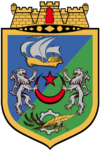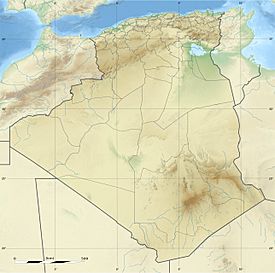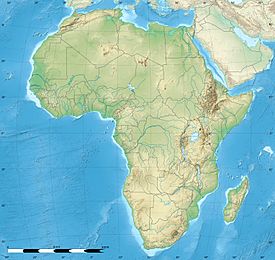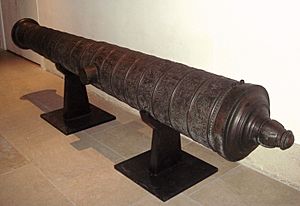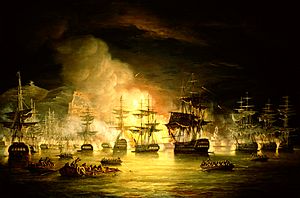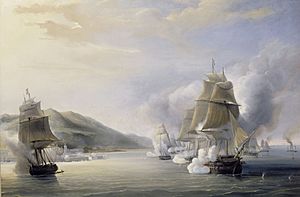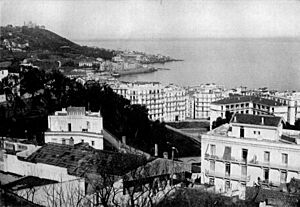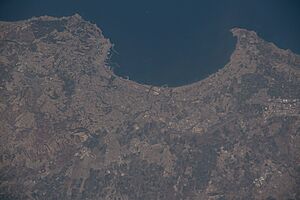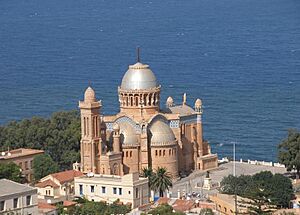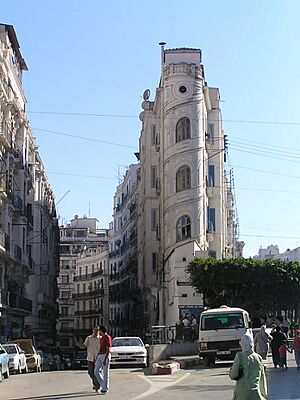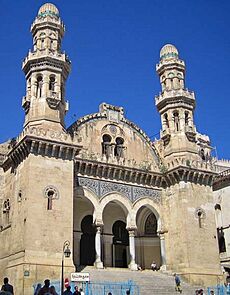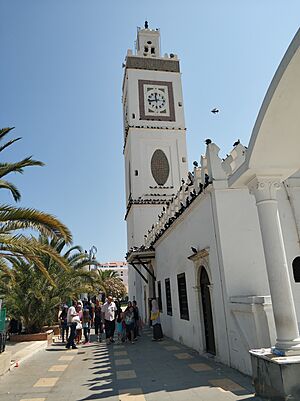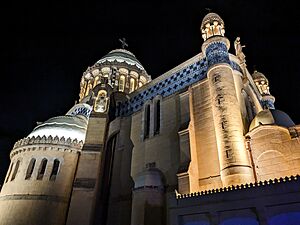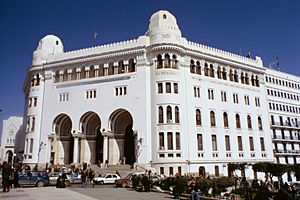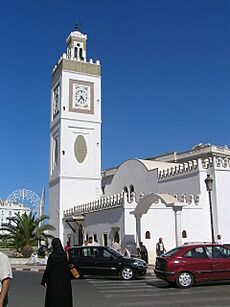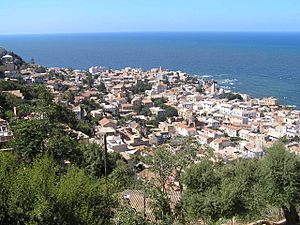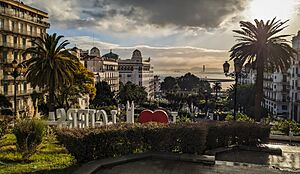Algiers facts for kids
Quick facts for kids
Algiers
الجزائر
al-Jazāʾir
|
|||
|---|---|---|---|
| الجزائر العاصمة | |||

Clockwise, top left: Coast of Algiers, Maqam Echahid (Martyrs' Memorial), Djamaa el Djazaïr, Ketchaoua Mosque, Kasbah of Algiers, Algiers Central Post Office, Ministry of Finance building
|
|||
|
|||
| Nicknames:
Algiers the White; Algiers the Dazzling
|
|||
| Country | |||
| Province | Algiers Province | ||
| District | Sidi M'Hamed District | ||
| Incorporated | 944 | ||
| Area | |||
| • Capital city | 363 km2 (140 sq mi) | ||
| • Metro | 1,190 km2 (460 sq mi) | ||
| Highest elevation | 424 m (1,391 ft) | ||
| Lowest elevation | 2 m (7 ft) | ||
| Population
(2011)
|
|||
| • Capital city | 4,510,000 | ||
| • Density | 12,424/km2 (32,180/sq mi) | ||
| • Metro density | 7,012/km2 (18,160/sq mi) | ||
| Time zone | UTC+01:00 (Central European Time) | ||
| • Summer (DST) | (Not Observed) | ||
| Postal codes |
16000–16132
|
||
| Area code(s) | (+213) 021 | ||
| Licence plate | 16 | ||
| Climate | Csa | ||
| Official name: Casbah of Algiers | |||
| Type: | Cultural | ||
| Criteria: | ii, v | ||
| Designated: | 1992 (16th session) | ||
| Reference #: | 565 | ||
| Region: | List of World Heritage Sites in North Africa | ||
Algiers (/ælˈdʒɪərz/ AL-jeerz; Arabic: الجزائر, romanized: al-Jazāʾir) is the administrative, political and economic capital and largest city of Algeria as well as the capital of the Algiers Province. The city's population at the 2008 census was 2,988,145 and in 2020 was estimated to be around 4,500,000. Located in the north-central part of the country, it extends along the shores of the Bay of Algiers in the heart of the Maghreb region making it classified among the biggest cities in North Africa, the Arab world and the Mediterranean Sea, making it a major center of culture, arts, gastronomy and trade.
The city contains the largest infrastructure facilities in the country; railway and highway connections with neighbouring cities and international links via the Houari Boumediene Airport and Algiers Ferry Terminal. Algiers possesses notable mass transit options, that includes the Algiers Metro, the city's subway system that recorded about 46 million passengers in 2023, alongside the Algiers tramway and several Gondola lift lines helping with the difference in elevation, in addition to many bus lines connecting the suburbs and major population centers.
Algiers houses many museums, art galleries and cultural centers, the most notable of which are Algiers Opera House, the Algerian National Theater Mahieddine Bachtarzi, Bardo National Museum (Algiers), the National Museum of Fine Arts of Algiers, The National Museum of Antiquities and Islamic Art; the "National Museum of Miniatures, Illumination and Calligraphy" located inside of Dar Mustapha Pacha; "Palais des Rais"; Algerian Admiralty Museum; the Central Military Museum adjacent to Maqam Echahid (Martyrs Memorial), a breathtaking monument that sits above the Martyrs National Museum. Other landmarks include Djamaa el Djazaïr, the 3rd biggest mosque in the world; Botanical Garden Hamma; Culture Palace Moufdi Zakaria; Grande Poste d'Alger, located adjacent to Kilometre zero; Ketchaoua Mosque; Notre-Dame d'Afrique; Emir Abdelkader Square as well as Martyr's Square. The city also contains a UNESCO World Heritage Site, the Casbah or citadel, that is a prominent example of Casbah and Medina.
This metropolis has hosted many sports events such as the 1975 Mediterranean Games, the 1990 African Cup of Nations alongside Annaba, the 1978 All-Africa Games and 2007 All-Africa Games, the 2018 African Youth Games, the 2022–23 CAF Confederation Cup, the 2023 Arab Games with 4 other cities; the 2022 African Nations Championship with 3 other cities. Sonatrach Petroleum Corporation and Air Algérie are headquartered in the city.
Contents
Names
The city's name is derived via French and Catalan Alger from the Arabic name al-Jazāʾir (الجزائر), "The Islands". This name refers to the four former islands which lay off the city's coast before becoming part of the mainland in 1525. Al-Jazāʾir is itself a truncated form of the city's older name Jazaʾir Banī Mazghanna (جزائر بني مزغانة), "islands of Banu Mazghanna", used by early medieval geographers such as Muhammad al-Idrisi and Yaqut al-Hamawi. The name was given by Buluggin ibn Ziri after he established the city on the ruins of the Phoenician city of Icosium in 950. During Ottoman rule, the name of the capital, al-Jazā'ir, was extended over the entire country, giving it the English name Algeria derived from the French name Algérie.
In classical antiquity, the ancient Greeks knew the town as Ikósion (Ancient Greek: Ἰκόσιον), which was Latinized as Icosium under Roman rule. The Greeks explained the name as coming from their word for "twenty" (εἴκοσι, eíkosi), supposedly because it had been founded by 20 companions of Hercules when he visited the Atlas Mountains during his labors.
Algiers is also known as el-Behdja (البهجة, "The Joyous") or "Algiers the White" (French: Alger la Blanche) for its whitewashed buildings.
History
Historical affiliations
Phoenicia and Punicia pre 202 BC
Numidia 202 BC–104 BC
Mauretania 104 BC-42 AD
Roman Empire 42-435
Vandal Kingdom 435–534
Byzantine Empire 534-700s
Umayyad Caliphate 700s–750
Abbasid Caliphate 750 AD-800
Aghlabids (As a vassal state of the Abbasids) 800 AD–909
Fatimid Caliphate 909–972
Zirid dynasty (As a vassal state of the Fatimid Caliphate) 972–1014
Hammadid dynasty 1014–1082
Almoravid Empire 1082-1151
Almohad Caliphate 1151–1235
![]() Thaaliba, (tributary of the Tlemcen) 1235-1516
Thaaliba, (tributary of the Tlemcen) 1235-1516
![]() Regency of Algiers, (tributary of the Ottoman Empire) 1516–1830
Regency of Algiers, (tributary of the Ottoman Empire) 1516–1830
![]() France, (French Algeria) 1830–1962
France, (French Algeria) 1830–1962
![]() Algeria 1962–present
Algeria 1962–present
Early history
The city's history is believed to date back to 1200 BC, but it was a small settlement without any significance until around the 3rd century BC when "Ikosim" became a small port town in Carthage where Phoenicians were trading with other Mediterranean ports. After the Battle of Cirta, Numidia got a hold of the town along with its neighboring regions at around 202 BC, after which the Punic wars started weakening the Berber nation. On 104 BC, following the capturing of Jughurta and executing him in Rome, the western half of his nation was given to Mauretania under the rule of Bocchus I. At around 42 AD, Claudius divided Mauretania into two provinces, Mauretania Caesariensis that included Icosium as one of its towns; the second province was Mauretania Tingitana and were deemed as Roman Municipiums, additionally they were given Latin rights by the emperor Vespasian. In 371-373 AD, Mauretania revolted with the help of Firmus in hopes of installing an independent State and Icosium was raided and damaged. Some clues show the presence of bishops in the region at this time.
In 435 AD, the Vandal Kingdom took control of northern Africa along the coasts of today's Tunisia and Algeria. The Western Roman Empire that was ruling the area allowed the Vandals to settle when it became clear that they could not be defeated by Roman military forces. Though the city was damaged again due to the fighting between the two armies, the town was still slowly growing in population.
Medieval history
In 534 AD, the Vandal kingdom was subjugated by the general Belisarius of the Eastern Roman Empire, making Icosium a part of the empire. In the early 7th century, "Beni Mezghenna" who are a Berber tribe belonging to the Sanhaja as cited by Ibn Khaldoun, settled on the plains of Icosium and the surrounding areas. Shortly after, in the late 7th century, the Muslim conquest of the Maghreb brought the Umayyad Caliphate into the region, but were faced with resistance from Berber forces led by Kahina and Kusaila in the 680s, who opposed the advancing Islamic armies. However, Hassan ibn al-Nu'man and Musa ibn Nusayr later defeated both Berber leaders, killing Kusaila at the Battle of Mamma (688) and killing Dihya at the Battle of Tabarka (702), leading to the subjugation of the Berber tribes, bringing Islamic rule into North Africa. The Abbasid Caliphate succeeded Umayyad Caliphate at around 750 AD. Independence movements across the Maghreb resulted in the breaking of two nations, the Idrisid dynasty and the Aghlabid Emirate but acted as agents of the Abbasids in Baghdad. Icosium fell into the hands of Aghlabids and abandoned the town. They were then overthrown by the Fatimids in 909 AD, who went on to control all of Ifriqiya by 969 AD.
The present city was re-founded in 972 AD by Buluggin ibn Ziri, who was appointed by the Faṭimid caliph al-Muʿizz as governor of al-Qayrawān and any other territory his nation, the Zirid Dynasty might reclaim from its enemies, the Zenata tribesmen. His state accordingly expanded its boundaries westward. In approximately 1014 AD, under the reign of Badis ibn al-Mansur, the dynasty was divided between the Zirids at al-Qayrawan in the east, and the Hammadids at Qal'at Bani Hammad; "Jazaʾir Banī Mazghanna", commonly known as "Algiers" as the new name of Icosium was absorbed into the Hammadid dynasty who in 1067 AD relocated to Bejaia and carried on a lively trade while most of North Africa was under a state of anarchy. In 1079 AD, Ibn Tashfin, a Sanhaja leader of the Almoravid Empire sent an army of 20,000 men from Marrakesh to push towards what is now Tlemcen to attack the "Banu Ya'la", the Zenata tribe occupying the area. Led by Mazdali ibn Tilankan, the army defeated the Banu Ya'la in battle near the valley of the Moulouya River and executed their commander, the son of Tlemcen's ruler. However, Mazdali ibn Tilankan did not push to Tlemcen right away as the city of Oujda was too strong to capture. Instead, Ibn Tashfin himself returned with an army in 1081 AD that captured Oujda and then conquered Tlemcen, massacring the Maghrawa forces there and their leader; He pressed on and by 1082 AD he had captured "Jazaʾir Banī Mazghanna".
In 1151 AD, Abd al-Mu'min launched an expedition to the east, conquering Bejaia in August 1152, the capital of the Hammadids; on their way, Beni Mezghanna did not succumb and was now under the Almohad Caliphate's control. The caliphate suffered from states breaking out of its rule, most notably, the Kingdom of Tlemcen in 1235 AD. The town once again came under the dominion of the Ziyanid sultans of the Kingdom but experienced a large measure of independence under Thaaliba amirs who settled the Mitidja plain at around 1200 AD.
Early modern history

The Kingdom of Tlemcen was the target of the Spanish Empire's and the Portuguese Empire's campaigns and conquests against its coasts, beginning in 1501 AD. However, Algiers continued to be of comparatively little importance until after the expulsion of the Moors from Spain, many of whom sought asylum in the city, after which the Spanish led by Pedro Navarro established a fortified base and garrison on one of the islets off the coast of Algiers, and named it "Peñón de Argel" or Peñón of Algiers, . By that time, Algiers had an emir, Salim al-Thumi who had to "swear obedience and loyalty" to Ferdinand II of Aragon who also imposed a levy intended to suppress the Barbary pirates.
Ottoman rule

In 1516, the amir of Algiers, Selim b. Teumi, invited the corsair brothers Oruç Reis and Hayreddin Barbarossa to expel the Spaniards. Oruç Reis came to Algiers, ordered the assassination of Selim, and seized the town and ousted the Spanish in the Capture of Algiers (1516). Hayreddin, succeeding Oruç after the latter was killed in battle against the Spaniards in the 1518 fall of Tlemcen, was the founder of the pashaluk, which subsequently became the beylik, of Algeria. Barbarossa lost Algiers in 1524 but regained it with the 1529 Capture of Peñón of Algiers, and then formally invited the Sultan Suleiman the Magnificent to accept sovereignty over the territory and to annex Algiers to the Ottoman Empire.

Algiers from this time became the chief seat of the Barbary pirates. In October 1541 in the Algiers expedition, the King of Spain and Charles V, Holy Roman Emperor sought to capture the city, but a storm destroyed a great number of his ships, and his army of some 30,000, chiefly made up of Spaniards, was defeated by the Algerians under their pasha, Hassan.
Formally part of the Ottoman Empire but essentially free from Ottoman control, starting in the 16th century Algiers turned to piracy and ransoming. Due to its location on the periphery of both the Ottoman and European economic spheres, and depending for its existence on a Mediterranean that was increasingly controlled by European shipping, backed by European navies, piracy became the primary economic activity. Repeated attempts were made by various nations to subdue the pirates that disturbed shipping in the western Mediterranean and engaged in slave raids as far north as Iceland. By the 17th century, up to 40% of the city's 100,000 inhabitants were enslaved Europeans. The United States fought two wars (the First and Second Barbary Wars) over Algiers' attacks on shipping.
Among the notable people held for ransom was the future Spanish novelist, Miguel de Cervantes, who was held captive in Algiers for almost five years, and wrote two plays set in Algiers of the period. The primary source for knowledge of Algiers of this period, since there are no contemporary local sources, is the Topografía e historia general de Argel (1612, but written earlier), published by Diego de Haedo, but whose authorship is disputed. This work describes in detail the city, the behavior of its inhabitants, and its military defenses, with the unsuccessful hope of facilitating an attack by Spain so as to end the piracy.
A significant number of renegades lived in Algiers at the time, Christians converted voluntarily to Islam, many fleeing the law or other problems at home. Once converted to Islam, they were safe in Algiers. Many occupied positions of authority, such as Samson Rowlie, an Englishman who became Treasurer of Algiers.
The city under Ottoman control was enclosed by a wall on all sides, including along the seafront. In this wall, five gates allowed access to the city, with five roads from each gate dividing the city and meeting in front of the Ketchaoua Mosque. In 1556, a citadel, Palace of the Dey was constructed at the highest point in the wall. A major road running north to south divided the city in two: The upper city (al-Gabal, or 'the mountain') which consisted of about fifty small quarters of Andalusian, Jewish, Moorish and Kabyle communities, and the lower city (al-Wata, or 'the plains') which was the administrative, military and commercial centre of the city, mostly inhabited by Ottoman Turkish dignitaries and other upper-class families.
On August 27, 1816, the Bombardment of Algiers took place city by a British squadron under Lord Exmouth (a descendant of Thomas Pellew, taken in an Algerian slave raid in 1715), assisted by men-of-war from the Kingdom of the Netherlands, destroying the corsair fleet harboured in Algiers.
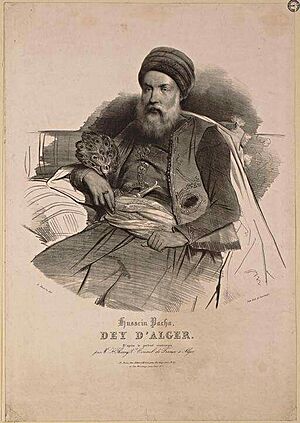
France and the Regency of Algiers had a commercial–political conflict called the Bakri-Busnach affair which has been bothering both nations in the 19th century. On April 29, 1827, foreign consuls and diplomatic agents gathered in the Palace of the Dey for a conference with the Regency of Algiers ruler Hussein Dey. On this occasion, the Dey struck the French consul in the face with the handle of a fly-whisk that was in his hands, which was a result of his frustration caused by France's failure to pay their debt. This event resulted in the "The fly-whisk incident", one of the most important events in Algerian history.
In an attempt by Charles X of France to increase his popularity amongst the French, he sought to bolster patriotic sentiment, and turn eyes away from his domestic policies, by treating the incident as a public insult and demanded an apology. Failure to respond was met by operations against the dey. A naval siege on the port of Algiers by the French Navy began the following days which lasted 3 years and impacted the French and Algerian economies due to their former extensive trade treaties.

Tensions only continued rising while the French Armed Forces were preparing for the 1830 invasion of Algiers. The naval fleet departed from Touron on May 25, 1830, and successfully reached the western coast of the Regency near what is today Sidi Fredj on June 14, 1830. The Algerian forces met their French opponents in the "Battle of Sidi Fredj" on June 19, 1830, to which the Dey's forces were defeated, this enabled the colonial army to advance into the city and made Hussein Dey surrender to French General de Bourmont on 5 July 1830.
French rule
Under French rule, Algiers became the capital of French Algeria, "an integral part of the French Republic" according to a formal annexation declared on June 22, 1834. France focused their interest into areas inhabited by locals, this in turn was the French conquest of Algeria that shared goals with its pacification efforts; Establishing a European cultural, economic and political presence in Africa without considering the indigenous population's lifestyle or connection to their land.
The city had a minority of "Pieds-noirs", Jews and European settlers due to laws and regulations put by the French government that granted French citizenship to them under the Crémieux Decree while releasing Code de l'indigénat giving inferiority to the "Arabs" and "Muslims" which were getting forcibly removed from their land in favor of building settlements. Many parts of the city were only accessible by settlers in an attempt to separate "Alger" by race, religion and language.
| Year | Active | Died in hospital | Killed in battle |
|---|---|---|---|
| 1831 | 71,190 | 1,005 | 55 |
| 1832 | 21,511 | 1,998 | 48 |
| 1833 | 26,681 | 2,512 | |
| 1834 | 29,858 | 1,991 | 24 |
| 1835 | 29,485 | 2,335 | 310 |
| 1836 | 29,897 | 2,139 | 606 |
| 1837 | 40,147 | 4,502 | 121 |
| 1838 | 48,167 | 2,413 | 150 |
| 1839 | 50,367 | 3,600 | 163 |
| 1840 | 61,204 | 9,567 | 227 |
| 1841 | 72,000 | 7,802 | 349 |
| 1842 | 70,853 | 5,588 | 225 |
| 1843 | 75,034 | 4,809 | 84 |
| 1844 | 82,037 | 4,664 | 167 |
| 1845 | 95,000 | 4,664 | 601 |
| 1846 | 99,700 | 6,862 | 116 |
| 1847 | 87,704 | 4,437 | 77 |
| 1848 | 75,017 | 4,406 | 13 |
| 1849 | 70,774 | 9,744 | |
| 1850 | 71,496 | 4,098 | |
| 1851 | 65,598 | 3,193 |
Many Europeans settled in Algiers, and by the early 20th century they formed a majority of the city's population. During the 1930s, the architect Le Corbusier drew up plans for a complete redesign of the colonial city. Le Corbusier was highly critical of the urban style of Algiers, describing the European district as "nothing but crumbling walls and devastated nature, the whole a sullied blot". He also criticised the difference in living standards he perceived between the European and African residents of the city, describing a situation in which "the 'civilised' live like rats in holes" whereas "the 'barbarians' live in solitude, in well-being". However, these plans were ultimately ignored by the French administration.
During World War II, Algiers was the first city to be seized from the Axis by the Allies in Operation Terminal, a part of Operation Torch.
Algerian War
Algiers also played a pivotal role in the Algerian War (1954–1962), a bloody independence struggle in which hundreds of thousands (estimates range between 350,000 and 1,500,000) died (mostly Algerians but also French and Pieds-Noirs). In particular, it saw the Battle of Algiers when the 10th Parachute Division of the French Army, starting on January 7, 1957, and on the orders of the French Minister of Justice François Mitterrand (who authorized any means "to eliminate the insurrectionists"), led attacks against the Algerian fighters for independence. Algiers remains marked by this battle, which was characterized by merciless fighting between FLN forces which carried out a guerrilla campaign against the French military and police and pro-French Algerian soldiers, and the French Army which responded with a bloody repression, torture and blanket terrorism against the native population. The demonstrations of May 13 during the crisis of 1958 provoked the fall of the Fourth Republic in France, as well as the return of General de Gaulle to power.
Independence
Algeria achieved independence on July 5, 1962, with Algiers as its capital. Since then, despite losing its entire pied-noir population, the city has expanded massively. It now has about five million inhabitants, or 10 percent of Algeria's population—and its suburbs now cover most of the surrounding Mitidja plain. Run by the FLN that had secured independence, Algiers became a member of Non-Aligned Movement during the Cold War. In October 1988, one year before the fall of the Berlin Wall, Algiers was the site of demonstrations demanding the end of the single-party system and the creation of a real democracy baptized the "Spring of Algiers". The demonstrators were repressed by the authorities (more than 300 dead), but the movement constituted a turning point in the political history of modern Algeria. The 1989 Algerian constitutional referendum took place and a new constitution was adopted that put an end to the one-party rule and saw the creation of more than fifty political parties, as well as official freedom of the press.
Crisis of the 1990s
The city became the theatre of many political demonstrations of all descriptions until 1993. In 1991, a political entity dominated by religious conservatives called the Islamic Salvation Front engaged in a political test of wills with the authorities. In the 1992 elections for the Algerian National Assembly, the Islamists garnered a large amount of support in the first round. Fearing an eventual win by the Islamists, the army canceled the election process, setting off the civil war between the State and armed religious conservatives which would last for a decade.
On December 11, 2007, two car bombs exploded in Algiers. One bomb targeted two United Nations office buildings and the other targeted a government building housing the Supreme Court of Algeria. The death toll was at least 62, with over two hundred injured in the attacks. However, only 26 remained hospitalized the following day. As of 2008[update], it is speculated that the attack was carried out by the Al Qaeda cell within the city.
Indigenous terrorist groups have been actively operating in Algeria since around 2002.
Geography
Location
Algiers is located in the north-central part of Algeria, extending along the Bay of Algiers and into the Mitidja plain and on top of and around the "Sahel of Algiers" and the Bouzaréah massif. It sits at roughly 2 m above sea level, while the highest point is at 407 m. The Oued El Harrach meets the sea while crossing near El Harrach, a neighbourhood of the city hence the name, while Mazafran River ends near the far western suburbs dividing Algiers Province and Tipaza Province; Both of these are called "Widan" which help in supplying agricultural needs in "Mitidja" which borders the Tell Atlas mountain range which could be spotted from the city.
Districts of Algiers
- The Casbah (of Al Qasbah, "the Citadel"), 1st District of Algiers: called Al-Djazaïr Al Mahroussa ("Well Kept Algiers"), is founded on the ruins of old Icosium. It is a small city of picturesque winding lanes built on a hill and descending towards the sea, divided into two sections: the High City and the Low City. It includes 17th-century buildings: Ketchaoua Mosque (rebuilt in the 18th century by the Dey Baba Hassan), El Djedid Mosque (built in 1660, at the time of Turkish regency), El Kebir Mosque (oldest of the mosques, built by Almoravid Youssef Ibn Tachfin and rebuilt in 1794), the Ali Bitchin Mosque (Raïs, 1623), and Dar Aziza, formerly part of the Palace of Jénina.
- Bab El Oued: Literally the River's Gate, the popular district which extends from the Casbah beyond "the gate of the river". It is the capital's darling and best liked borough. Famous for its square with "the three clocks" and for its "market Triplet", it is also a district of workshops and manufacturing plants.
- Edge of sea: from 1840, the architects Pierre-August Guiauchain and Charles Frédéric Chassériau designed new buildings apart from the Casbah, town hall, law courts, buildings, theatre, palace of the Governor, and casino, to form an elegant walk bordered by arcades which is today the boulevard Che Guevara (formerly the Boulevard of the Republic).
- Kouba (will daira of Hussein-dey): Kouba is an old village which was absorbed by the expansion of the town of Algiers. Kouba quickly developed under the French colonial era then continued growing due to formidable demographic expansion that Algiers saw after the independence of Algeria in 1962. It is today a district of Algiers which is largely made up of houses, villas, and buildings not exceeding five stories.
- El Harrach, a suburb of Algiers, is located about 10 kilometres (6 miles) to the east of the city.
- The communes of Hydra, Ben Aknoun, El-Biar and Bouzareah form what the inhabitants of Algiers call the "Heights of Algiers". These communes shelter the majority of the foreign embassies of Algiers, of many ministries and university centres, which makes it one of the administrative and policy centres of the country.
- The Didouche Mourad street is located in the 3rd district Of Algiers. It extends from the Grande Post office to the Heights of Algiers. It crosses in particular the place Audin, the Faculty of Algiers, The Crowned Heart and the Freedom Park (formerly Galland). It is bordered by smart stores and restaurants along most of its length. It is regarded as the heart of the capital.
Climate
Algiers has a Mediterranean climate (Köppen climate classification Csa). Its proximity to the Mediterranean Sea aids in moderating the city's temperatures. As a result, Algiers usually does not see the extreme temperatures that are experienced in the adjacent interior. Algiers on average receives roughly 600 millimetres (24 in) of rain per year, the bulk of which is seen between October and April. The precipitation is higher than in most of coastal Mediterranean Spain, and similar to most of coastal Mediterranean France, as opposed to the interior North African semi-arid or arid climate.
Snow is very rare; in 2012, the city received 100 millimetres (4 in) of snowfall, its first snowfall in eight years.
| Climate data for Algiers (Houari Boumediene Airport) 1991–2020, extremes 1838–present | |||||||||||||
|---|---|---|---|---|---|---|---|---|---|---|---|---|---|
| Month | Jan | Feb | Mar | Apr | May | Jun | Jul | Aug | Sep | Oct | Nov | Dec | Year |
| Record high °C (°F) | 27.6 (81.7) |
31.4 (88.5) |
36.3 (97.3) |
36.5 (97.7) |
41.1 (106.0) |
44.6 (112.3) |
48.7 (119.7) |
47.5 (117.5) |
44.4 (111.9) |
39.5 (103.1) |
34.4 (93.9) |
30.4 (86.7) |
48.7 (119.7) |
| Mean daily maximum °C (°F) | 17.1 (62.8) |
17.5 (63.5) |
19.7 (67.5) |
21.8 (71.2) |
25.0 (77.0) |
29.0 (84.2) |
32.1 (89.8) |
32.9 (91.2) |
29.8 (85.6) |
26.5 (79.7) |
21.2 (70.2) |
18.2 (64.8) |
24.2 (75.6) |
| Daily mean °C (°F) | 11.3 (52.3) |
11.5 (52.7) |
13.6 (56.5) |
15.6 (60.1) |
18.8 (65.8) |
22.6 (72.7) |
25.7 (78.3) |
26.6 (79.9) |
23.9 (75.0) |
20.4 (68.7) |
15.7 (60.3) |
12.6 (54.7) |
18.2 (64.8) |
| Mean daily minimum °C (°F) | 5.5 (41.9) |
5.6 (42.1) |
7.5 (45.5) |
9.4 (48.9) |
12.6 (54.7) |
16.2 (61.2) |
19.4 (66.9) |
20.4 (68.7) |
17.9 (64.2) |
14.3 (57.7) |
10.1 (50.2) |
7.0 (44.6) |
12.2 (54.0) |
| Record low °C (°F) | −3.3 (26.1) |
−1.9 (28.6) |
−1.0 (30.2) |
−0.8 (30.6) |
2.6 (36.7) |
5.5 (41.9) |
9.0 (48.2) |
9.5 (49.1) |
8.2 (46.8) |
4.1 (39.4) |
−0.1 (31.8) |
−2.3 (27.9) |
−3.3 (26.1) |
| Average precipitation mm (inches) | 84.2 (3.31) |
72.1 (2.84) |
58.9 (2.32) |
58.0 (2.28) |
39.0 (1.54) |
8.6 (0.34) |
1.5 (0.06) |
10.6 (0.42) |
27.5 (1.08) |
51.5 (2.03) |
102.7 (4.04) |
86.4 (3.40) |
601 (23.7) |
| Average precipitation days (≥ 1 mm) | 8.4 | 8.7 | 7.0 | 6.1 | 4.3 | 1.4 | 0.4 | 1.4 | 4.0 | 5.4 | 9.2 | 8.2 | 64.5 |
| Average relative humidity (%) | 71 | 66 | 65 | 62 | 66 | 66 | 67 | 65 | 68 | 66 | 68 | 68 | 67 |
| Mean monthly sunshine hours | 139.5 | 158.2 | 207.7 | 228.0 | 300.7 | 300.0 | 353.4 | 325.5 | 267.0 | 198.4 | 153.0 | 145.7 | 2,777.1 |
| Mean daily sunshine hours | 4.5 | 5.6 | 6.7 | 7.6 | 9.7 | 10.0 | 11.4 | 10.5 | 8.9 | 6.4 | 5.1 | 4.7 | 7.6 |
| Source 1: NOAA | |||||||||||||
| Source 2: Arab Meteorology Book (humidity and sun), Meteo Climat (record highs and lows) | |||||||||||||
Climate change
A 2019 paper published in PLOS One estimated that under Representative Concentration Pathway 4.5, a "moderate" scenario of climate change where global warming reaches ~2.5–3 °C (4.5–5.4 °F) by 2100, the climate of Algiers in the year 2050 would most closely resemble the current climate of Perth in Australia. The annual temperature would increase by 2.6 °C (4.7 °F), and the temperature of the warmest month by 1.9 °C (3.4 °F), while the temperature of the coldest month would be 3.8 °C (6.8 °F) higher. According to Climate Action Tracker, the current warming trajectory appears consistent with 2.7 °C (4.9 °F), which closely matches Representative Concentration Pathway (RCP) 4.5.
Moreover, according to the 2022 IPCC Sixth Assessment Report, Algiers is one of 12 major African cities (Abidjan, Alexandria, Algiers, Cape Town, Casablanca, Dakar, Dar es Salaam, Durban, Lagos, Lomé, Luanda and Maputo) which would be the most severely affected by the future sea level rise. It estimates that they would collectively sustain cumulative damages of U$65 billion under RCP 4.5 and US$86.5 billion for the high-emission scenario RCP 8.5 by the year 2050. Additionally, RCP 8.5 combined with the hypothetical impact from marine ice sheet instability at high levels of warming would involve up to US$137.5 billion in damages, while the additional accounting for the "low-probability, high-damage events" may increase aggregate risks to $187 billion for the "moderate" RCP 4.5, $206 billion for RCP 8.5 and $397 billion under the high-end ice sheet instability scenario. Since sea level rise would continue for about 10,000 years under every scenario of climate change, future costs of sea level rise would only increase, especially without adaptation measures. The Casbah is on a list of 10 African World Heritage Site most threatened by sea level rise.
Local architecture
There are many public buildings of interest, including the whole Kasbah quarter, Martyrs Square (Sahat ech-Chouhada ساحة الشهداء), the government offices (formerly the British consulate), the "Grand", "New", and Ketchaoua Mosques, the Roman Catholic cathedral of Notre Dame d'Afrique, the Bardo Museum, the old Bibliothèque Nationale d'Alger—a moorish palace built in 1799–1800 and the new National Library, built in a style reminiscent of the British Library.
The main building in the Kasbah was begun in 1516 on the site of an older building, and served as the palace of the deys until the French conquest. A road has been cut through the centre of the building, the mosque turned into barracks, and the hall of audience allowed to fall into ruin. There still remain a minaret and some marble arches and columns. Traces exist of the vaults in which were stored the treasures of the dey.
Djamaa el Kebir (Jamaa-el-Kebir الجامع الكبير) is the oldest mosque in Algiers. It was first built by Yusuf ibn Tashfin, but reconstructed many times. The pulpit (minbar منبر) bears an inscription showing that the building existed in 1097. The minaret was built by the sultan of Tlemcen, in 1324. The interior of the mosque is square and is divided into aisles by columns joined by Moorish arches.
The New Mosque (Jamaa-el-Jedid الجامع الجديد), dating from the 17th century, is in the form of a Greek cross, surmounted by a large white cupola, with four small cupolas at the corners. The minaret is 27 metres (89 ft) high. The interior resembles that of the Grand Mosque.
The church of the Holy Trinity (built in 1870) stands at the southern end of the rue d'Isly near the site of the demolished Fort Bab Azoun باب عزون. The interior is richly decorated with various coloured marbles. Many of these marbles contain memorial inscriptions relating to the British residents (voluntary and involuntary) of Algiers from the time of John Tipton, the first English consul, in 1580 (NB Some sources give 1585). One tablet records that in 1631 two Algerine pirate crews landed in Ireland, sacked Baltimore, and enslaved its inhabitants.
The Ketchaoua Mosque (Djamaa Ketchaoua جامع كتشاوة), at the foot of the Casbah, was before independence in 1962 the cathedral of St Philippe, itself made in 1845 from a mosque dating from 1612. The principal entrance, reached by a flight of 23 steps, is ornamented with a portico supported by four black-veined marble columns. The roof of the nave is of Moorish plaster work. It rests on a series of arcades supported by white marble columns. Several of these columns belonged to the original mosque. In one of the chapels was a tomb containing the bones of Geronimo. The building seems a curious blend of Moorish and Byzantine styles.
Algiers possesses a college with schools of law, medicine, science and letters. The college buildings are large and handsome. The Bardo Museum holds some of the ancient sculptures and mosaics discovered in Algeria, together with medals and Algerian money.
The port of Algiers is sheltered from all winds. There are two harbours, both artificial—the old or northern harbour and the southern or Agha harbour. The northern harbour covers an area of 95 hectares (235 acres). An opening in the south jetty affords an entrance into Agha harbour, constructed in Agha Bay. Agha harbour has also an independent entrance on its southern side. The inner harbour was begun in 1518 by Khair-ad-Din Barbarossa (see History, below), who, to accommodated his pirate vessels, caused the island on which was Fort Penon to be connected with the mainland by a mole. The lighthouse which occupies the site of Fort Penon was built in 1544.
Algiers was a walled city from the time of the deys until the close of the 19th century. The French, after their occupation of the city (1830), built a rampart, parapet and ditch, with two terminal forts, Bab Azoun باب عزون to the south and Bab-el-Oued اد to the north. The forts and part of the ramparts were demolished at the beginning of the 20th century, when a line of forts occupying the heights of Bouzareah بوزريعة (at an elevation of 396 metres (1,299 ft) above the sea) took their place.
Notre Dame d'Afrique, a church built (1858–1872) in a mixture of the Roman and Byzantine styles, is conspicuously situated overlooking the sea, on the shoulder of the Bouzareah hills, 3 km (2 mi) to the north of the city. Above the altar is a statue of the Virgin depicted as a black woman. The church also contains a solid silver statue of the archangel Michael, belonging to the confraternity of Neapolitan fishermen.
Villa Abd-el-Tif, former residence of the dey, was used during the French period, to accommodate French artists, chiefly painters, and winners of the Abd-el-Tif prize, among whom Maurice Boitel, for a while of two years. Nowadays, Algerian artists are back in the villa's studios.
Monuments
- Notre Dame d'Afrique, accessible by one cable car, is one of the city's most outstanding monuments: located in the district of Z' will ghara, the basilica was built around 1858.
- Monument des Martyrs (Marquand E' chahid): an iconic concrete monument commemorating the Algerian war for independence. The monument was opened in 1982 on the 20th anniversary of Algeria's independence. It is fashioned in the shape of three standing palm leaves which shelter the "Eternal Flame" beneath. At the edge of each palm leaf stands a statue of a soldier, each representing a stage of Algeria's struggle.
- The El Jedid mosque at the Place des Martyrs near the port.
- Place of the Emir Abdelkader (formerly Bugeaud): in memory of the famous emir Abd El-Kader, resistant during French conquest of Algeria.
- Grand Post Office (1910, by Voinot and Tondoire): construction of the neo-Moorish type which is in full centre town of Algiers.
- The Jardin d'essai (Garden of Test; El-Hamma): situated in the east of Algiers, it extends over 80 hectares (198 acres) and contains exotic plants and gardens. It was created in 1832 by A. Hardy.
- Villa Abd-el-Hair, with the top of the Garden of test, one of the old residences of the dey, where until 1962, were placed the artists prizes winner of Price Abd-el-Hair, and in particular Maurice Boitel and Andre Hamburg.
- Citadel.
- Riadh El-Feth (shopping centre and art gallery).
- Ketchaoua Mosque (This mosque became the Saint-Philippe cathedral during colonization before becoming again a mosque).
- National Library, is in the district of El HAMMA and was built in the 1990s.
- Djamaa el Kebir at the Rue de la Marine. It is the oldest mosque of Algiers and was built during the reign of the Almoravid sultan Yusuf ibn Tashfin.
- Le Bastion 23 – Palais des Rais, built in 1576 by Dey Ramdhan Pacha and located in the lower Casbah in the Bab El Oued neighborhood.
Demographics
| Year | Population |
|---|---|
| 1977 (Census) | 1,523,000 |
| 1987 (Census) | 1,507,241 |
| 1998 (Census) | 2,086,212 |
| 2008 (Census) | 2,364,230 |
As of 2012, Algiers has a population of about 3,335,418.
The ethnic distribution is 53% from an Arabic-speaking background, 44% from a Berber-speaking background and 3% foreign-born.
Economy
Algiers is an important economic, commercial and financial center, with a stock exchange capitalized at 60 million euros. Algiers contributes to 20% of Algeria's GDP (51 Billions $ in 2024.) The city has the highest cost of living of any city in North Africa, as well as the 50th highest worldwide, as of March 2007, having gained one position compared to the previous year.
Mohamed Ben Ali El Abbar, president of the Council of Administration of the Emirate Group EMAAR, presented five "megaprojects" to Algerian President Abdelaziz Bouteflika, during a ceremony which took place Saturday, July 15, in the People's Palace of Algiers. These projects will transform the city of Algiers and its surroundings by equipping them with a retail area and restoration and leisure facilities.
The first project will concentrate on the reorganization and the development of the infrastructures of the railway station "Aga" located in the downtown area. The ultramodern station intended to accommodate more than 80.000 passengers per day, will become a centre of circulation in the heart of the grid system, surrounded by commercial offices and buildings and hotels intended for travellers in transit. A shopping centre and three high-rise office buildings rising with the top of the commercial zone will accompany the project.
The second project will not relate to the bay of Algiers and aims to revitalize the sea front. The development of the 44 km (27 mi) sea front will include marinas, channels, luxury hotels, offices, apartments of great standing, luxury stores and leisure amenities. A crescent-shaped peninsula will be set up on the open sea. The project of the bay of Algiers will also comprise six small islands, of which four of round form, connected to each other by bridges and marinas and will include tourist and residential complexes.
The third project will relate to restructuring an area of Algiers, qualified by the originators of the project of "city of wellness". El Abbar indicated to the journalists that the complex would be "agreeable for all those which will want to combine tourism and well-being or tourism and relaxation". The complex will include a university, a research center and a medical centre. It should also include a hospital complex, a care centre, a hotel zone, an urban centre and a thermal spa with villas and apartments. The university will include a medical school and a school for care male nurses which will be able to accommodate 500 students. The university campus will have the possibility of seeing setting up broad ranges of buildings of research laboratories and residences.
Another project relates to technological implantation of a campus in Sidi Abdellah, 25 km (16 mi) south-east from Algiers. This 90 hectares (222 acres) site will include shopping centres, residential zones with high standard apartments and a golf course surrounded by villas and hotels. Two other residential zones, including 1.800 apartments and 40 high standard villas, will be built on the surrounding hills.
The fifth project is that of the tourist complex Colonel Abbès, which will be located 25 km (16 mi) west from Algiers. This complex will include several retail zones, meeting places, and residential zones composed of apartments and villas with views of the sea.
There is another project under construction, by the name of Algiers Medina. The first step of the project is nearly complete.
A Hewlett-Packard office for French-speaking countries in Africa is in Algiers.
Tourist attractions
Some 20 km (12 mi) to the west of Algiers are such seaside resorts as Sidi Fredj (ex-Sidi Ferruch), Palm Beach, Douaouda, Zéralda, and the Club of the Pines (residence of State); there are tourist complexes, Algerian and other restaurants, souvenir shops, supervised beaches, and other amenities. The city is also equipped with important hotel complexes such as the hotel Hilton, El-Aurassi or El Djazair. Algiers also has the first water park in the country. The tourism of Algiers is growing but is not as developed as that of the larger cities in Morocco or Tunisia.
Education
The presence of a large diplomatic community in Algiers prompted the creation of multiple international educational institutions. These schools include :
- American International School of Algiers;
- British School Algiers
- El Kalimat School (English-language school);
- Lycée International Alexandre-Dumas d'Alger (French school);
- Roma Italian School of Algiers;
- Russian Embassy School in Algiers.
There was formerly the École japonaise d'Alger (アルジェ日本人学校 Aruje Nihonjin Gakkō), a school for Japanese children.
Public transport
- ETUSA (urban and suburban bus transportation for Algiers) operates bus service in Algiers and the surrounding suburbs. 54 lines are operating, with service from 5:30 a.m. to 12:45 a.m.
- SNTF (national railroad company) operates commuter-rail lines connecting the capital to the surrounding suburbs.
- Algiers Metro, opened November 1, 2011.
- Algiers tramway, opened on May 8, 2011.
- Houari Boumediene Airport is located 20 km (12 mi) from the city. The airport serves domestics, many European cities, West Africa, the Middle East, Asia and North America. On July 5, 2006, a new international air terminal was opened for service. The terminal is managed by Aéroports de Paris.
4 urban beltways:
- El Madania – Belouizdad
- Notre Dame d'Afrique – Bologhine
- Memorial des Martyres/Riad el Feth – Jardin d'essais
- Palais de la culture – Oued Kniss
Sports
Algiers is the sporting centre of Algeria. The city has a number of professional clubs in the variety of sports, which have won national and international titles. Among the sports facilities within the city, there is an enormous sporting complex – Complex of OCO – Mohamed Boudiaf. This includes the Stade 5 Juillet 1962 (capacity 64,000), a venue for athletics, an Olympic swimming pool, a multisports room (the Cupola), an 18-hole golf course, and several tennis courts.
The following major sporting events have been held in Algiers (not-exhaustive list):
- Mediterranean Games 1975.
- All-Africa Games 1978, 2007.
- African Cup of Nations 1990.
- African Handball Nations Championship 1989, 2001.
- Pan Arab Games 2004.
- FIBA Africa Championship 2005.
- Men's U19 World Championship 2005.
Football clubs
Major association football club based in Algiers include:
- MC Alger
- CR Belouizdad
- USM Alger
International relations
Twin towns – sister cities
Algiers is twinned with:
- Santiago, Chile
In addition, many of the wards and cities within Algiers maintain sister-city relationships with other foreign cities.
Cooperation agreements
Algiers has cooperation agreements with:
Films about Algiers
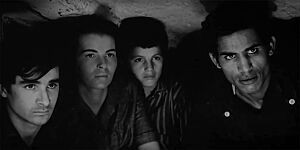
- Algiers, 1938, starring Charles Boyer and Hedy Lamarr, and directed by John Cromwell;
- The Battle of Algiers, 1966, directed by Gillo Pontecorvo;
- Tahya ya Didou, Alger Insolite, 1970, Mohammed Zinet;
- Bab El-Oued City, 1994, directed by Merzak Allouache;
- Viva Laldjérie, 2003, directed by Nadir Moknèche, with Biyouna and Lubna Azabal;
- Bab el Web, 2004, directed by Merzak Allouache, with Samy Naceri, Julie Gayet, Faudel;
- Once upon a time in the Oued, 2005, directed by Djamel Bensalah;
- Beur, White, Red, 2005, directed by Mahmoud Zemmouri.
- Delice Paloma, 2007, directed by Nadir Moknèche, with Biyouna and Nadia Kaci.
- Abbott and Costello in the Foreign Legion, 1950, starring Bud Abbott and Lou Costello.
- Carry on Spying 1964, directed by Gerald Thomas with Kenneth Williams, Charles Hawtrey, Barbara Windsor & Renee Houston
Notable people
- Sidi Abd al-Rahman al-Tha'alibi, 15th-century theologian and sufi.
- Sidi Ahmed Zouaoui, 15th-century theologian and sufi.
- Raphael Zeror (1681–1737), Algerian rabbi
- Sidi M'hamed Bou Qobrine, 18th-century theologian and sufi.
- Mohamed ben Zamoum, 19th-century resistant against French colonization.
- Khalid ibn Hashim, 19th-20th-century resistant against French colonization.
- Albert Camus 20th-century Nobel Laureate
- Abdelhalim Bensmaia, 20th-century scholar, reformist, humanist and musician.
- Lyès Deriche, 20th-century leader of the Algerian national political movement.
- Brahim Boushaki, 20th-century theologian and sufi.
- Ali La Pointe, 20th-century militant of the Algerian national political movement.
- Mohamed Aïchaoui, 20th-century militant of the Algerian national political movement.
- Mohamed Seghir Boushaki, 20th-century leader of the Algerian national political movement.
- El Hadj M'Hamed El Anka, 20th-century artist.
- Ahmed Mahsas, 20th-century leader of the Algerian national political movement.
- Hocine Mezali, 20th-21st-century journalist and writer.
- Djamila Bouhired, 20th-century militant of the Algerian national political movement.
- Hassiba Ben Bouali, 20th-century militant of the Algerian national political movement.
- Mohamed Belouizdad, 20th-century leader of the Algerian national political movement against the French.
- Djamila Boupacha, 20th-century militant of the Algerian national political movement.
- Mohamed Bencheneb, 20th-century professor, writer and historian.
- Mourad Didouche, 20th-century leader of the Algerian national political movement.
- Islam Slimani, footballer
- Ali Haroun, 20th-century politician and lawyer.
- Mohamed Missouri, 20th-century boxer and coach.
- Hamdan Khodja, 19th-century dignitary and scholar.
- Mohamed Belhocine, 20th-21st-century professor of internal medicine and epidemiology.
- Amine ibn El Boushaki, 20th-21st-century judoka.
- Amina Belouizdad, 20th-century television presenter.
- Ali Fawzi Rebaine, 21st-century politician and doctor.
- Mohamed Arkab, 20th-21st-century politician and engineer.
- Rezki Zerarti, 20th-21st-century politician and engineer.
- Gaston Ricci (1869–1952), French politician, born in Algiers.
- Henri Fiori (1881–1963), French politician, born in Algiers.
- Raymond Laquière (1881–1973), French politician, born in Algiers.
- Jean-Marie Guastavino (1886–1960), French politician, born in Algiers.
- Mustapha Khedali (1934–2008), Algerian football player and manager
- Alain Dorval (1946-2024), French voice actor. He dubbed Sylvester Stallone in French versions.
- Abdelatif Alouach (born 1976), freediver
- Mohamed Harrat (born 1976), footballer
- Lotfi Laggoun (born 1984 in Alger), footballer
- Lyna Khoudri (born 1992), Algerian-French actress
- Arezki Hamza Dembri (born 2004), Algerian footballer
- Tony Gatlif (born 1948), French film director
See also
 In Spanish: Argel para niños
In Spanish: Argel para niños



